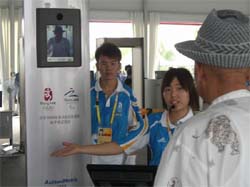

To ensure the safety of spectators and athletes at the biggest-ever Olympic Games being held in Beijing, automation experts from CAS have developed China's first system to identify individuals by their facial features, and successfully applied it to the opening night security check on 8 August.
To ensure the safety of spectators and athletes at the biggest-ever Olympic Games being held in Beijing, automation experts from CAS have developed China's first system to identify individuals by their facial features, and successfully applied it to the opening night security check on 8 August.
The first time such technology was adopted as safety measures in the Olympic history, it identified and verified more than 80 thousand people who went through some 100 facial recognition surveillance machines "Authenmetric" before they entered the National Stadium, known as the Bird's Nest, to enjoy the spectacular ceremony.
Just like fingerprints, everyone's face is unique with hundreds of "landmarks." These landmarks are distributed more densely around the golden triangle of the eyes, nose and mouth. The computer captures a person's facial image(s), and analyzes the details of the landmarks and distances and angles between them. This information is put into a database which can contain information about millions of faces. When the person is caught on camera again, the computer searches the database until it finds the best match.
Prof. LI Ziqing (Stan Z. LI) and colleagues with the Center for Biometrics and Security Research (CBSR), CAS Institute of Automation, spent more than one year designing and working out the system, a high-performance innovation which combines cutting-edge facial recognition technology with radio frequency identification card technology.
Under the real-name registration policy, ticket holders of the Beijing 2008 opening and closing ceremonies were required to submit their personal information and photos in advance. Then these images are analyzed, recorded in detail, and put into the database. When the audiences pass security checkpoints one by one, their faces will be checked against and identified by the database.
"Facial recognition is very natural. It is what we have been doing since our birth," Li says. It can also adapt to inconsistent light conditions and different statures. In fact, security experts already consider this novel technology the most natural, visualized and highly-potential biometric identification method to become popular soon on important occasions such as major sports games, conferences, exams and places like airports which see mass of people ebb and flow.
Technology is changing the way the Olympics will be broadcast, judged, trained for and participated in. With support from the Ministry of Science and Technology, CAS researchers have made various S&T contributions to the event, ranging from water purification system, mass data storage technology to environment monitoring.
Prof. Li was trained in the UK and worked at Microsoft Research before entering the CAS institute. He now runs the world's largest team for biometrics.
The system was co-built, under the leadership of CBSR, by Authenmetric Co. Ltd., Beijing Aerospace Changfeng Co. Ltd., Beijing Municipal Public Security Bureau, etc.






